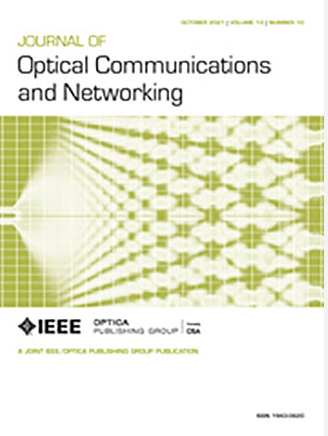使用wss和OCSs混合的大规模非阻塞OXC
IF 4.3
2区 计算机科学
Q1 COMPUTER SCIENCE, HARDWARE & ARCHITECTURE
引用次数: 0
摘要
互联网流量的激增正在推动传统的单光纤固定网格光网络向每根光纤波长更少的多光纤灵活网格网络转变。设计一个大规模的光交叉连接(OXC)来适应这些变化是具有挑战性的,因为标准的OXC的可扩展性受到波长选择交换机(WSS)端口数量的限制。现有的方案要么存在插入损耗大,要么缺乏非阻塞特性,要么不支持灵活的网格。为此,我们提出了一类使用wss和端口级光电路开关(ocs)的异构oxc。我们的想法是使用wss来处理波长切换,使用OCSs来扩大OXC的尺寸。在柔性网格环境下,我们证明了异质网格在线路侧不阻塞,在添加/删除侧无色、无方向、无争议的条件。此外,我们的分析表明,我们的建议所要求的wss端口数仅由网络中的波长数控制,而不是由OXC的维度控制。此外,我们的设计具有低损耗和小滤波效应,因为每个光路只需要通过OXC中的两个wss。本文章由计算机程序翻译,如有差异,请以英文原文为准。
Large-scale and nonblocking OXC using a hybrid of WSSs and OCSs
The surge in Internet traffic is driving traditional single-fiber fixed-grid optical networks to change toward multi-fiber flex-grid networks with fewer wavelengths per fiber. Designing a large-scale optical cross-connect (OXC) to adapt to these changes is challenging because the scalability of standard OXCs is limited by the port count of the wavelength-selective switch (WSS). The existing proposals either suffer from high insertion loss, lack a nonblocking property, or cannot support flexible grids. To this end, we propose a class of heterogeneous OXCs, using WSSs and port-level optical circuit switches (OCSs). Our idea is to employ WSSs to handle wavelength switching and OCSs to scale up the dimension of the OXC. In the context of flexible grids, we prove the conditions under which the heterogeneous OXCs are nonblocking on the line side, and colorless, directionless, and contentionless on the add/drop side. Also, our analysis shows that the port count of WSSs required by our proposals is governed only by the number of wavelengths in the network, rather than the dimension of the OXC. Also, our designs have low loss and a small filtering effect, as each lightpath only needs to pass through up to two WSSs in the OXC.
求助全文
通过发布文献求助,成功后即可免费获取论文全文。
去求助
来源期刊
CiteScore
9.40
自引率
16.00%
发文量
104
审稿时长
4 months
期刊介绍:
The scope of the Journal includes advances in the state-of-the-art of optical networking science, technology, and engineering. Both theoretical contributions (including new techniques, concepts, analyses, and economic studies) and practical contributions (including optical networking experiments, prototypes, and new applications) are encouraged. Subareas of interest include the architecture and design of optical networks, optical network survivability and security, software-defined optical networking, elastic optical networks, data and control plane advances, network management related innovation, and optical access networks. Enabling technologies and their applications are suitable topics only if the results are shown to directly impact optical networking beyond simple point-to-point networks.

 求助内容:
求助内容: 应助结果提醒方式:
应助结果提醒方式:


